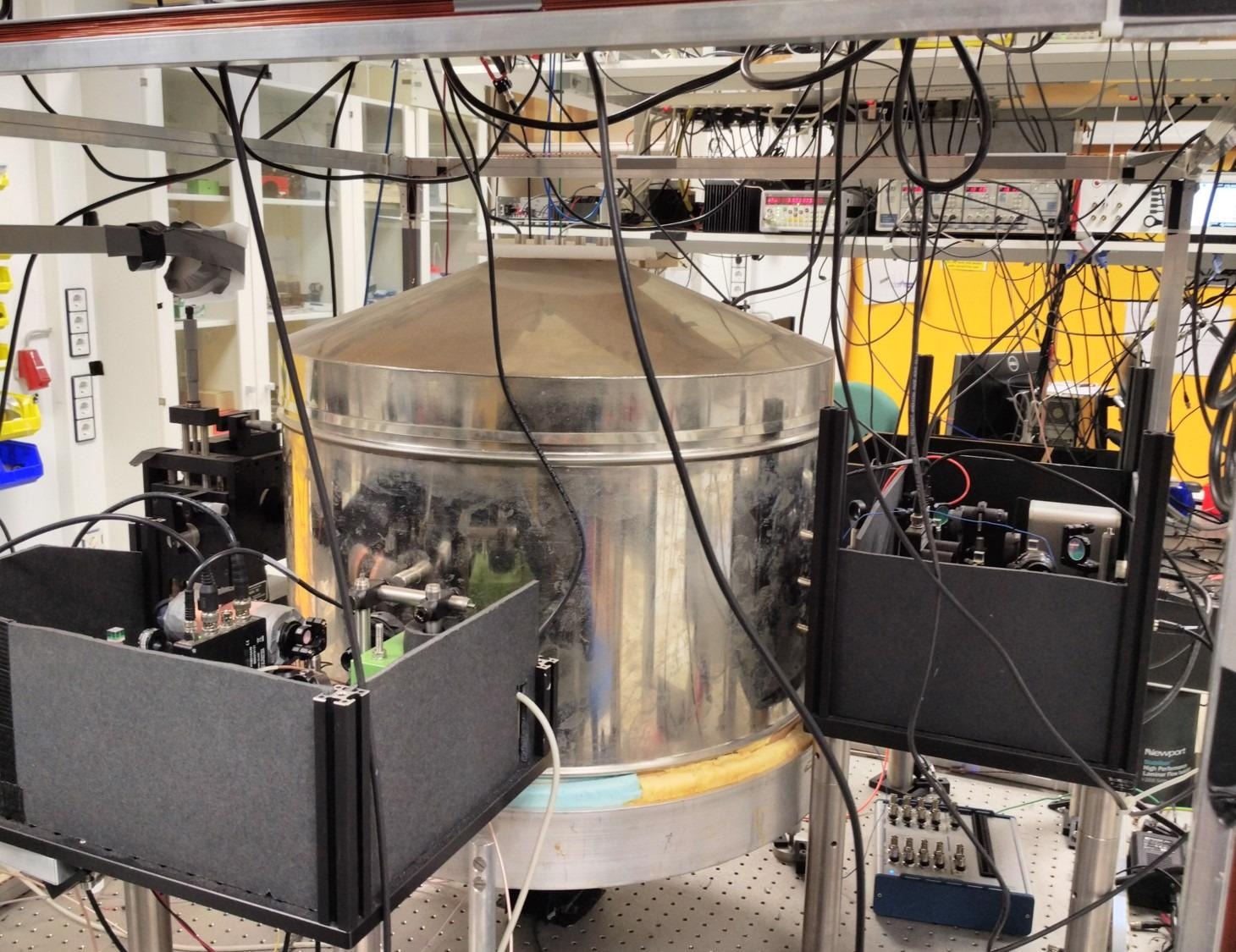For the first time, detailed data on the search for dark matter using a global network of optical magnetometers has been published by an international group of scientists with primary participation from the PRISMA+ Cluster of Excellence at Johannes Gutenberg University Mainz (JGU) and the Helmholtz Institute Mainz (HIM).
 Mainz-based setup of the GNOME Network. (Image Credit: Hector Masia Roig).
Mainz-based setup of the GNOME Network. (Image Credit: Hector Masia Roig).
According to the researchers, dark matter fields should generate a characteristic signal pattern that can be sensed by correlated measurements at various stations of the GNOME network. GNOME stands for Global Network of Optical Magnetometers for Exotic Physics Searches.
Examination of data from a one-month continuous GNOME operation has not yet generated a corresponding indication. However, the measurement facilitates the formulation of constraints on the characteristics of dark matter, as the scientists report in the esteemed journal Nature Physics.
Behind GNOME are magnetometers spread across the world in Germany, Poland, Israel, Serbia, South Korea, Australia, China and the United States.
With GNOME, scientists are mainly keen to advance the search for dark matter – one of the 21st century’s most stimulating challenges of fundamental physics. After all, the scientific community is aware that many mystifying astronomical observations, such as the spectrum of cosmic background radiation or the rotation speed of stars in galaxies, can best be illuminated by dark matter.
"Extremely light bosonic particles are considered one of the most promising candidates for dark matter today. These include so-called axion-like particles – ALPs for short," explained Professor Dr. Dmitry Budker, professor at PRISMA+ and at HIM, an institutional collaboration of Johannes Gutenberg University Mainz and the GSI Helmholtzzentrum für Schwerionenforschung in Darmstadt.
They can also be considered as a classical field oscillating with a certain frequency. A peculiarity of such bosonic fields is that – according to a possible theoretical scenario – they can form patterns and structures. As a result, the density of dark matter could be concentrated in many different regions – discrete domain walls smaller than a galaxy but much larger than Earth could form, for example.
Dr. Dmitry Budker, Professor, PRISMA+, Johannes Gutenberg University Mainz
"If such a wall encounters the Earth, it is gradually detected by the GNOME network and can cause transient characteristic signal patterns in the magnetometers," stated Dr. Arne Wickenbrock, one of the study's co-authors. "Even more, the signals are correlated with each other in certain ways – depending on how fast the wall is moving and when it reaches each location."
The network meanwhile comprises 14 magnetometers spread across eight countries around the world, and nine of them supplied data for the present analysis. The measurement principle is founded on an interaction of dark matter with the nuclear spins of the atoms in the magnetometer.
The atoms are stimulated using a laser at a certain frequency, causing the nuclear spins to orient in one direction. A prospective dark matter field can disturb this direction, which is quantifiable.
Symbolically speaking, one can envisage that the atoms in the magnetometer dance around in confusion at first, as elucidated by Hector Masia-Roig, a doctoral student in the Budker group and also an author of the present research.
When they 'hear' the right frequency of laser light, they all spin together. Dark matter particles can throw the dancing atoms out of balance. We can measure this perturbation very precisely.
Hector Masia Roig, Study Author and Doctoral Student, Johannes Gutenberg University Mainz
Now the grid of magnetometers becomes crucial: When the Earth moves across a spatially limited wall of dark matter, the dancing atoms in all stations are steadily disturbed. One of these stations is situated in a laboratory at the HIM.
Only when we match the signals from all the stations can we assess what triggered the disturbance. Applied to the image of the dancing atoms, this means: If we compare the measurement results from all the stations, we can decide whether it was just one brave dancer dancing out of line or actually a global dark matter disturbance.
Hector Masia Roig, Study Author and Doctoral Student, Johannes Gutenberg University Mainz
In the present study, the researchers examined information from a one-month continuous operation of GNOME. The result: Statistically important signals were not seen in the inspected mass range from one femtoelectronvolt (feV) to 100,000 feV.
Contrarily, this means that scientists can shrink the range in which such signals could hypothetically be sensed even further than before. For scenarios that depend upon discrete dark matter walls, this is a significant result – "even though we have not yet been able to detect such a domain wall with our global ring search," expresses Joseph Smiga, another Ph.D. student in Mainz and author of the study.
Future work of the GNOME partnership will concentrate on enhancing the magnetometers as well as the data analysis. Specifically, the constant operation should be even more stable. This is vital to dependably search for signals that exist longer than an hour.
Furthermore, the earlier alkali atoms in the magnetometers are to be substituted by noble gases. Under the title Advanced GNOME, the scientists suppose this will result in significantly better sensitivity for future measurements in the hunt for dark matter and ALPs.
Journal Reference:
Afach, S., et al. (2021) Search for topological defect dark matter with a global network of optical magnetometers. Nature Physics. doi.org/10.1038/s41567-021-01393-y.